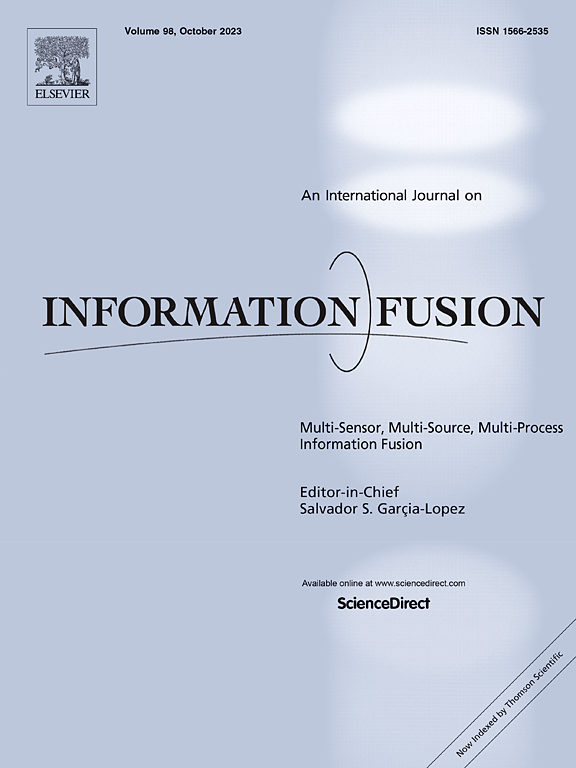Joint content-aware and difference-transform lightweight network for remote sensing images semantic change detection
IF 14.7
1区 计算机科学
Q1 COMPUTER SCIENCE, ARTIFICIAL INTELLIGENCE
引用次数: 0
Abstract
Advancements in Earth observation technology have enabled effective monitoring of complex surface changes. Semantic change detection (SCD) using high-resolution remote sensing images is crucial for urban planning and environmental monitoring. However, existing deep learning-based SCD methods, which combine semantic segmentation (SS) and binary change detection (BCD), face challenges in lightweight design and consistency between semantic and change results, limiting their accuracy and applicability. To overcome these limitations, we propose the Joint Content-Aware and Difference-Transform Lightweight Network (CDLNet). CDLNet features a lightweight architecture, skip connections, and a multi-task decoding mechanism. The Temporal-Spatial Content-Aware Fusion module (TSAF) in the SS decoding branch incorporates change information to improve semantic classification accuracy within change regions. The Multi-Type Temporal Difference-Transform module (MTDT) in the BCD decoding branch enhances change localization for accurate SCD through efficient transformation of temporal difference features. Experiments on the SECOND, HiUCD mini, MSSCD, and Landsat-SCD datasets demonstrate that CDLNet outperforms thirteen state-of-the-art methods, achieving average improvements of 1.41%, 1.53% and 1.49% in the , and metrics, respectively. Ablation studies confirm the effectiveness of the TSAF and MTDT modules and the rationality of multi-task loss weight configuration. Furthermore, CDLNet utilizes only 20% of the parameters (12.88M) and 7.5% of the FLOPs (30.11G) of the leading model, achieving an inference speed of 41 FPS, which underscores its superior lightweight characteristics. The results indicate that CDLNet offers excellent detection performance, generalization, and robustness within a lightweight framework. The code of our paper is accessible at: https://github.com/zjd1836/CDLNet.
面向遥感图像语义变化检测的联合内容感知和差分变换轻量级网络
地球观测技术的进步使对复杂地表变化的有效监测成为可能。基于高分辨率遥感图像的语义变化检测(SCD)在城市规划和环境监测中至关重要。然而,现有的基于深度学习的SCD方法将语义分割(SS)和二进制变化检测(BCD)相结合,在轻量级设计和语义与变化结果的一致性方面面临挑战,限制了其准确性和适用性。为了克服这些限制,我们提出了联合内容感知和差分变换轻量级网络(CDLNet)。CDLNet具有轻量级架构、跳过连接和多任务解码机制。SS译码分支中的时空内容感知融合模块(TSAF)引入变化信息,提高了变化区域内的语义分类精度。BCD译码分支中的Multi-Type Temporal difference - transform module (MTDT)通过对时间差分特征的高效变换,增强了精确SCD的变化定位。在SECOND、HiUCD mini、MSSCD和Landsat-SCD数据集上的实验表明,CDLNet优于13种最先进的方法,在F1scd、IoUc和Score指标上分别实现了1.41%、1.53%和1.49%的平均改进。消融研究证实了TSAF和MTDT模块的有效性和多任务减重配置的合理性。此外,CDLNet仅利用了领先模型20%的参数(12.88M)和7.5%的FLOPs (30.11G),实现了41 FPS的推理速度,突出了其优越的轻量级特性。结果表明,CDLNet在轻量级框架内提供了出色的检测性能、泛化和鲁棒性。我们论文的代码可以在https://github.com/zjd1836/CDLNet上获得。
本文章由计算机程序翻译,如有差异,请以英文原文为准。
求助全文
约1分钟内获得全文
求助全文
来源期刊

Information Fusion
工程技术-计算机:理论方法
CiteScore
33.20
自引率
4.30%
发文量
161
审稿时长
7.9 months
期刊介绍:
Information Fusion serves as a central platform for showcasing advancements in multi-sensor, multi-source, multi-process information fusion, fostering collaboration among diverse disciplines driving its progress. It is the leading outlet for sharing research and development in this field, focusing on architectures, algorithms, and applications. Papers dealing with fundamental theoretical analyses as well as those demonstrating their application to real-world problems will be welcome.
 求助内容:
求助内容: 应助结果提醒方式:
应助结果提醒方式:


